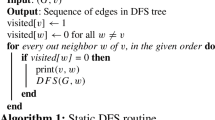Abstract
We give anO(log4 n)-timeO(n 2)-processor CRCW PRAM algorithm to find a hamiltonian cycle in a strong semicomplete bipartite digraph,B, provided that a factor ofB (i.e., a collection of vertex disjoint cycles covering the vertex set ofB) is computed in a preprocessing step. The factor is found (if it exists) using a bipartite matching algorithm, hence placing the whole algorithm in the class Random-NC.
We show that any parallel algorithm which can check the existence of a hamiltonian cycle in a strong semicomplete bipartite digraph in timeO(r(n)) usingp(n) processors can be used to check the existence of a perfect matching in a bipartite graph in timeO(r(n)+n 2 /p(n)) usingp(n) processors. Hence, our problem belongs to the class NC if and only if perfect matching in bipartite graphs belongs to NC.
We also consider the problem of finding a hamiltonian path in a semicomplete bipartite digraph.
Similar content being viewed by others
References
K. Abrahamson, N. Dadoun, D. G. Kirkpatrick, and T. Przytycka, A simple parallel tree contraction algorithm,J. Algorithms,10 (1989), 287–302.
R. J. Anderson and G. L. Miller, Deterministic parallel list ranking,Proc. 3rd Egean Workshop on Computing, 1988, pp. 81–90.
E. Bampis, M. El Haddad, Y. Manoussakis, and M. Santha, A parallel reduction of hamilton cycle to hamilton path in tournaments,J. Algorithms,19 (1995), 432–440.
J. Bang-Jensen, Arc-local tournament digraphs: a generalization of tournaments and bipartite tournaments, submitted.
J. Bang-Jensen, G. Gutin, and J. Huang, A sufficient condition for a complete multipartite digraph to be hamiltonian,Discrete Math., to appear.
A. Bar-Noy and J. Naor, Sorting, minimal feedback sets, and Hamiltonian paths in tournaments,SIAM J. Discrete Math.,3 (1990), 7–20.
L. W. Beineke and R. J. Wilson,Selected Topics in Graph Theory 3, Academic Press, New York, 1988.
J. A. Bondy and U. S. R. Murty,Graph Theory with Applications, MacMillan, New York, 1976.
R. P. Brent. The parallel evaluation of general arithmetic expressions,J. Assoc. Comput. Mach.,21 (1974), 201–208.
R. Cole, Parallel merge sort,SIAM J. Comput.,17 (1988), 770–785.
R. Cole and U. Vishkin, Approximate and exact parallel scheduling with applications to list, tree and graph problems,Proc. 27th IEEE Symp. on Foundations of Computer Science, 1986, pp. 478–491.
D. Coppersmith and S. Winograd, Matrix multiplication via arithmetric progressions,Proc. 19th ACM Symp. on Theory of Computing, 1987, pp. 1–6.
A. V. Goldberg, S. A. Plotkin, and P. M. Vaidya, Sublinear-time parallel algorithms for matching and related problems.Proc. 29th IEEE Symp. on Foundations of Computer Science, 1988, pp. 174–185.
G. Gutin, A criterion for complete bipartite digraphs to be hamiltonian,Vestsĩ Acad. Navuk BSSR Ser. Fĩz.-Mat. Navuk, No. 1 (1984), 99–100 (in Russian).
G. Gutin, Effective characterization of complete bipartite digraphs that have a hamiltonian path,Kibernetica, No. 4 (1985), 124–125 (in Russian).
P. Hell and M. Rosenfeld, The complexity of finding generalized paths in tournaments,J. Algorithms,4 (1982), 303–309.
A. Israeli and Y. Shiloach. An improved parallel algorithm for maximal matching,Inform. Process. Lett.,22 (1986), 57–60.
R. M. Karp and V. Ramachandran, Parallel algorithms for shared-memory machines, inHandbook of Theoretical Computer Science, ed. J. Van. Leuwen, Elsevier, Amsterdam, 1990, pp. 869–941.
R. E. Ladner and M. J. Fisher, Parallel prefix sum computation.J. Assoc. Comput. Mach.,27 (1980), 830–838.
Y. Manoussakis, A linear-time algorithm for finding hamiltonian cycles in tournaments,Discrete Appl. Math.,36 (1992), 199–201.
G. L. Miller, V. Ramachandran, and E. Kaltofen, Efficient parallel evaluation of straight line code and arithmetic circuits,SIAM J. Comput.,17 (1988), 687–695.
G. L. Miller and J. Reif, Parallel tree contraction and its application,Proc. 26th IEEE Symp. on Foundations of Computer Science, 1985, pp. 478–489.
K. Mulmuley, U. V. Vazirani, and V. B. Vazirani, Matching is as easy as matrix inversion,Combinatorica,7 (1987), 105–113.
Author information
Authors and Affiliations
Additional information
Communicated by G. N. Frederickson.
Rights and permissions
About this article
Cite this article
Bang-Jensen, J., El Haddad, M., Manoussakis, Y. et al. Parallel algorithms for the hamiltonian cycle and hamiltonian path problems in semicomplete bipartite digraphs. Algorithmica 17, 67–87 (1997). https://doi.org/10.1007/BF02523239
Received:
Revised:
Issue Date:
DOI: https://doi.org/10.1007/BF02523239




